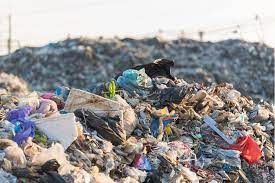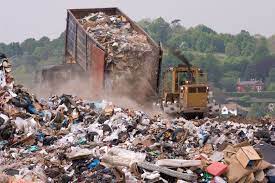Landfills are designated areas or sites where waste materials are disposed of and buried in the ground. They are commonly used as a method of waste management and are intended to contain and isolate waste from the surrounding environment.
Landfills are typically regulated and engineered to minimize environmental contamination and public health risks associated with the decomposition and handling of waste.
The process of creating a landfill involves several steps. First, a suitable location is selected based on factors such as geology, hydrology, and proximity to population centers. The site is then prepared with liners and barriers to prevent the leakage of pollutants into the soil and groundwater.
Waste materials are transported to the landfill and deposited in designated areas called “cells” or “pits.” The waste is spread out and compacted to maximize the available space. Modern landfills are designed to manage different types of waste, including municipal solid waste (household trash), industrial waste, construction debris, and sometimes hazardous materials.
To minimize the environmental impact, landfills are equipped with various systems such as leachate collection systems to capture and treat liquids that percolate through the waste, and gas collection systems to capture and manage the gases produced by the decomposition of organic waste.
Over time, as waste decomposes, landfills can produce potentially harmful gases like methane, which is a potent greenhouse gas. To mitigate these emissions, many landfills now employ systems to collect and treat the gases, either for conversion into energy or for release into the atmosphere in a controlled manner.
Proper management and regulation are crucial to ensure that landfills are operated in an environmentally responsible manner. Measures such as monitoring, maintenance, and long-term planning are essential to minimize the potential for groundwater contamination, air pollution, and other negative impacts on surrounding ecosystems and communities.
Efforts are being made worldwide to reduce reliance on landfills through waste reduction, recycling, composting, and other sustainable waste management practices.
The goal is to minimize the amount of waste sent to landfills and promote a more circular economy where materials are reused, recycled, or recovered for energy generation instead of being disposed of in landfills.
Unearthing the Impact of Landfills on Our Environment

Landfills have long been the primary method of waste disposal in many parts of the world. These vast repositories of discarded materials, both organic and inorganic, have played a significant role in managing the growing waste generated by modern societies.
However, as our understanding of the environment has evolved, so too has our awareness of the detrimental impact landfills can have on our surroundings. This article aims to delve into the multifaceted consequences of landfills on the environment, shedding light on the urgent need for sustainable waste management practices.
One of the most immediate and apparent environmental impacts of landfills is the release of greenhouse gases (GHGs). As organic waste decomposes in these sites, it produces substantial quantities of methane, a potent greenhouse gas that contributes to climate change.
Methane is approximately 25 times more potent than carbon dioxide in terms of its global warming potential, exacerbating the already pressing issue of greenhouse gas emissions. Consequently, landfills have emerged as a significant source of methane emissions worldwide, further intensifying the challenges associated with climate change mitigation.
Moreover, the leachate produced by landfills poses a severe threat to the quality of our water resources. Rainwater that percolates through the waste undergoes chemical reactions, resulting in the formation of a toxic liquid known as leachate. Leachate contains various pollutants, including heavy metals, organic compounds, and pathogens, which can contaminate groundwater and surface water bodies.
The uncontrolled release of leachate can lead to the destruction of aquatic ecosystems and the disruption of the delicate balance of surrounding habitats. Consequently, the contamination of water sources not only endangers aquatic life but also poses significant health risks to human populations relying on these resources for drinking water.
Read Also: How To Generate Money From Littered Wastes
Landfills also impact air quality in their vicinity, emitting a range of noxious gases and unpleasant odors. Besides methane, landfills release other volatile organic compounds (VOCs) such as benzene, toluene, and formaldehyde, which are associated with various adverse health effects.
These compounds can contribute to the formation of smog and ground-level ozone, leading to respiratory problems, cardiovascular issues, and other respiratory ailments. The noxious odors emanating from landfills can cause significant discomfort and reduce the quality of life for nearby communities.
In addition to the immediate environmental consequences, landfills also present long-term challenges. The improper disposal of waste in landfills often results in the accumulation of hazardous materials, including heavy metals, pesticides, and plastic pollutants. Over time, these contaminants can leach into the surrounding soil, posing a threat to both flora and fauna.
The persistence of certain chemicals in the environment can disrupt ecosystems, impairing the reproductive and developmental processes of wildlife. Furthermore, the accumulation of non-biodegradable materials, particularly plastics, in landfills contributes to the global plastic pollution crisis, which has far-reaching implications for marine life, terrestrial ecosystems, and human health.
Addressing the impact of landfills on the environment requires a comprehensive approach to waste management. Relying solely on traditional landfill methods is no longer sustainable or responsible. Instead, a shift towards sustainable waste management practices is imperative.
This includes prioritizing waste reduction and recycling, investing in advanced waste treatment technologies such as composting and anaerobic digestion, and promoting the circular economy principles to minimize waste generation and maximize resource efficiency.
Furthermore, governments and regulatory bodies must enforce stringent regulations and standards to ensure proper landfill design, operation, and closure. Implementing measures such as lining systems, leachate collection and treatment systems, and landfill gas capture can help mitigate the environmental impacts of landfills.
Additionally, promoting public awareness and education about waste management, recycling, and the consequences of landfills can foster behavioral changes that lead to more sustainable waste disposal practices.
The impact of landfills on our environment is undeniable and multifaceted. From greenhouse gas emissions and water contamination to air pollution and long-term ecological consequences, landfills pose significant threats to the delicate balance of our ecosystems and the health of both wildlife and human populations.
To address these challenges, a paradigm shift is necessary, focusing on sustainable waste management practices that prioritize waste reduction, recycling, and resource efficiency.
Governments, regulatory bodies, and local communities must collaborate to develop and enforce robust regulations and standards for landfill operations. This includes implementing effective waste collection and segregation systems, investing in advanced waste treatment technologies, and promoting the adoption of circular economy principles.
Read Also: Revolutionizing Wastewater Treatment
Landfill designs should incorporate measures to prevent leachate leakage and to capture and utilize landfill gases effectively. Furthermore, public awareness and education campaigns play a vital role in changing societal attitudes towards waste disposal.
By informing individuals about the consequences of landfills on the environment and promoting sustainable alternatives, such as composting and recycling, we can foster behavioral changes that lead to more responsible waste management practices.
It is also crucial to explore innovative approaches to waste management, such as waste-to-energy technologies, where feasible and environmentally sound. These methods can help reduce the volume of waste sent to landfills while simultaneously generating renewable energy.
Ultimately, unearthing the impact of landfills on our environment requires a collective effort from individuals, communities, industries, and governments. By embracing sustainable waste management practices and prioritizing the preservation of our environment, we can mitigate the adverse effects of landfills and pave the way for a cleaner, healthier, and more sustainable future.
Technological advancements and research play a significant role in finding innovative solutions to mitigate the impact of landfills on the environment. Scientists and engineers are continuously exploring new methods for waste management, such as waste conversion technologies, bioremediation techniques, and improved landfill designs. These advancements aim to minimize the environmental footprint of landfills and maximize resource recovery.
For instance, advancements in landfill gas capture and utilization have shown promising results in reducing methane emissions. Landfill gas, which consists of methane and carbon dioxide, can be collected and used as a renewable energy source. By implementing gas collection systems and converting the captured methane into electricity or heat, landfills can not only reduce their greenhouse gas emissions but also contribute to the generation of clean energy.
Additionally, the development of alternative waste treatment technologies, such as anaerobic digestion and composting, provides viable alternatives to traditional landfill disposal. Anaerobic digestion involves the breakdown of organic waste in the absence of oxygen, producing biogas and nutrient-rich digestate.
Biogas can be used as a renewable energy source, while the digestate can be utilized as organic fertilizer. Composting, on the other hand, facilitates the natural decomposition of organic waste into nutrient-rich compost, which can be used in agriculture and landscaping.
Moreover, exploring opportunities for recycling and waste-to-material conversion is crucial in reducing the amount of waste sent to landfills. Recycling initiatives, including separate collection and sorting of recyclable materials, help conserve resources, reduce energy consumption, and decrease the need for landfill space.
Additionally, technologies such as pyrolysis and gasification can convert non-recyclable waste into valuable products like biofuels, syngas, and chemicals. Collaboration among stakeholders is key to effectively addressing the impact of landfills on the environment.
Governments, industries, waste management companies, researchers, and communities must work together to develop integrated waste management strategies that prioritize sustainable practices.
This includes establishing comprehensive waste management plans, investing in infrastructure for waste collection and treatment, and supporting research and development in waste management technologies.
Unearthing the impact of landfills on our environment necessitates a holistic approach that encompasses technological advancements, regulatory measures, public awareness, and collaborative efforts.
By adopting sustainable waste management practices, embracing innovative technologies, and promoting a circular economy, we can mitigate the adverse effects of landfills and move towards a more environmentally conscious and resilient future. Together, we can preserve the integrity of our ecosystems, safeguard human health, and pave the way for a sustainable planet for generations to come.
Read Also: DIY – How to Make Homemade Earrings

